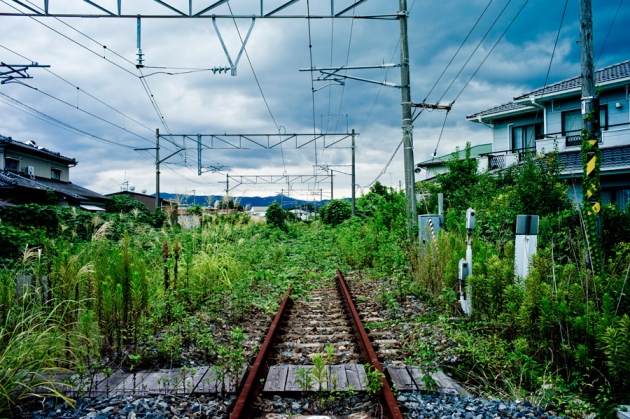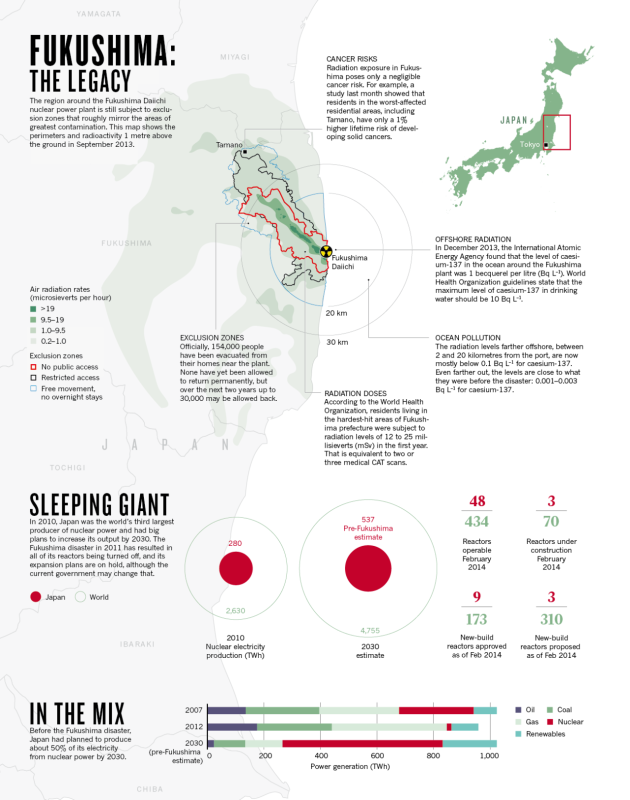[일본] 에너지 딜레마에 빠진 일본
일본 후쿠시마 다이치 원전(Fukushima Daiichi nuclear power station)의 노심용융을 야기한 쓰나미가 발생한지 3년이 지난 후, 일본은 에너지 정책(energy policy) 관점에서 교차로에 서있는 실정이다. 후쿠시마 사고에 따라서 이전 일본정부의 ‘제로-원자력’에 대한 약속에도 불구하고, 지난주에 발표된 법 초안은 현 정부가 원자력을 다시 도입하려는 것으로 제안하고 있다. 녹색 기술의 선두주자가 될 목적으로 후쿠시마 현에 9800억 달러(104조5천억 원) 규모의 재생에너지 연구센터를 건설하는 준공식을 몇 주 앞둔 상황에서 이와 같은 법안이 발표되었다. 일본의 에너지 정책은 어떤 방향으로 갈 것인가?
2011년 후쿠시마 사고 이후 일본의 에너지 정책을 뒤집은 이 법안은 재생에너지원으로부터 일본의 에너지를 모두 공급해야 하는 제안을 포함했다. 일본에서 후쿠시마 현보다 방사능 누출이 더 심각한 지역은 없다. 그래서 후쿠시마 현은 2040년까지 공급되는 에너지에 대해서 엄청난 태양열 패널과 풍력단지를 활용할 계획이다. 세계에서 가장 규모가 큰 7MW 부양식 풍력터빈 2기는 내년에 운전에 들어갈 예정이다.
4월에 후쿠시마 재생에너지 연구소(Fukushima Renewable Energy Institute)의 설립을 통해서 후쿠시마 현의 미래 에너지 계획이 보강될 것이다. 이 연구소는 손상된 원전에서 서쪽으로 60 km 떨어진 킬리야마에 위치하며, 수쿠바 소재 고급산업 과학기술연구소(National Institute of Advanced Industrial Science and Technology, AIST)에 의해서 설립된다. 이 연구소는 파나소닉과 샤프와 같은 전자회사로부터 관심을 받고 있다. 독일 Freiburg에 태양에너지 시스템 연구소인 Fraunhofer과의 협력을 포함하여 외국 기업들과의 협력은 한창 진행 중이다. 내부적으로는 100명의 연구원들이 태양, 수소, 풍력 및 지열을 포함한 분야에 대해서 연구를 진행할 것이다.
Tetsuo Munakata 부회장은 이 연구소가 AIST의 장기 연구프로그램으로 확대될 것이라고 말하며, 7년 안에 80마이크로미터의 태양열 셀에 대한 실리콘 웨이퍼의 두께를 감소시키는 것과 같은 구체적인 목표를 언급했다.
그러나 일부 사람들은 성공하기에 어려운 쇼로서 이 연구소를 바라본다. 비관론자들은 일본의 태양열 패널 메이커가 아직 중국 제작자의 낮은 비용과 경쟁하는데 노력하고 있다고 지적했다. 동경에 위치한 지속가능한 에너지 정책 연구소의 소장인 Tetsunari Iida는 후쿠시마 연구소가 경험 인력이 부족하고 내각 관료들과 함께 교착상태에 빠질 수 있을 것이라고 말했다. “나는 우리가 실제적인 결과 관점에서 많은 기대를 할 수 있다고 생각하지 않는다”고 그는 덧붙였다.
회의론자들 역시 일본 정부가 원자력에 대해서 긍정적인 움직임이 있는 분위기를 지적했다. 후쿠시마 다이치 원전에 저장된 방사능 오염수의 계속적인 노출과 주변에 광범위한 제한 지역에도 불구하고, 에너지 계획의 초안에서 정부가 48기의 원자로를 재가동할 것이라고 말하고 있다. 이 48기는 후쿠시마 사고 이후 모두 정지된 상태였다. 이 계획은 올 봄에 승인될 것으로 예상된다.
그러나 Munakata는 새로운 후쿠시마 연구소가 정부의 재생에너지 정책을 강조한다고 말한다. “재생에너지에 투자하지 않는 방법은 없다”고 그는 말했다.
[원문보기]
Japan caught up in energy dilemma
Three years after a tsunami led to reactor meltdowns at Japan’s Fukushima Daiichi nuclear power station, the country is at a crossroads in terms of energy policy. A draft law released last week suggests that, despite the previous government’s promise of a ‘zero-nuclear’ future in the wake of the disaster, the current administration is ready to re-embrace the technology. Yet the announcement came just weeks before the opening of a ¥10-billion (US$98-million) renewable-energy research centre in Fukushima prefecture that aims to be at the forefront of green technology. Which way will Japan turn?
The reformist wave that swept Japan after the 2011 disaster included proposals to supply all of the country’s energy from renewable sources. Nowhere is taking this more seriously than Fukushima prefecture, which plans to use an array of giant solar panels, biomass plants and windfarms to supply all of its energy by 2040. Two floating, 7-megawatt wind turbines, the world’s largest, are scheduled to come online in the next year.
The opening of the Fukushima Renewable Energy Institute in April will bolster the prefecture’s vision. The institute is in Koriyama, 60 kilometres west of the stricken nuclear plant, and has been established by the Tsukuba-based National Institute of Advanced Industrial Science and Technology (AIST). It has attracted interest from electronics companies such as Panasonic and Sharp, and foreign collaborations are also in the pipeline, including one with the Fraunhofer Institute for Solar Energy Systems in Freiburg, Germany. Inside, about 100 researchers will work across areas including solar, hydrogen, wind and geothermal power.
Deputy director Tetsuo Munakata says that the institute will expand on the long-running research programmes of AIST, and he points to concrete goals such as reducing the thickness of silicon wafers for solar cells to 80 micrometres in seven years.
But some see the institute as a showpiece with little chance of success. Critics point out that Japanese solar-panel makers are already struggling to compete with the lower costs of Chinese manufacturers. Tetsunari Iida, head of the Institute for Sustainable Energy Policies in Tokyo, says that the Fukushima institute lacks experienced hands and will get bogged down with ministerial bureaucracy. “I don’t think we can expect much in terms of practical results,” he says.
Sceptics also point to what seems to be a government move towards nuclear energy. Despite continued leaks of radioactive water stored at Fukushima Daiichi, and extensive exclusion zones remaining around it (see ‘Fukushima: the legacy’), the draft energy plan says that the government will push to restart Japan’s 48 operable reactors, all of which were closed after the earthquake that triggered the disaster. The plan is expected to be approved in the spring.
But Munakata says that the new institute also underlines the government’s commitment to renewable energy. “There’s no way it isn’t going to keep investing in renewables,” he says.
| 










































